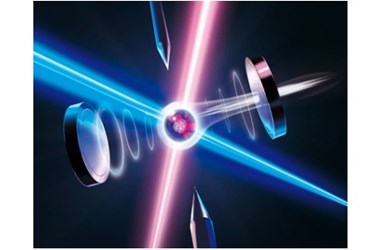Integrated Nano-Photonic Chips Promise Network Speeds In Terabit Range

Optimizing and accelerating optic fibers, a core component of the global communication networks and infrastructure, works as a crucial economic multiplier. Researchers of the Institute of Electrical and Optical Communications Engineering (INT) at the University of Stuttgart and the Institut für Mikroelektronik Stuttgart (IMS CHIPS) achieved a crucial new world record in the coupling efficiency between optical fibers and photonic integrated waveguides, which enables a whole new category of computer chips on silicon wafers. This enables record high energy efficiency, meaning less speed limiting heat loads, in the integration of silicon chips.
It is also an important step to decrease the energy consumption of data transfers in general, enabling ever more internet processes for the same price.
The internet and telecommunications are based on an optical core network that connects cities worldwide using glass fibers. These can carry light with very low losses over long distances. Based on a study published by CISCO, the mobile data transfer (smartphones) will solely increase from 885 petabytes per month (end of 2012) up to ten exabytes per month in the year 2017. To avoid a similar increasing energy consumption of our telecommunication systems, more efficient networks have to be developed, which represents nowadays a very interesting and actual research field.
Researchers of the INT and IMS CHIPS have developed a fabrication process to realize complex sender and receiver structures that are integrated on silicon wafers -- involving an integrated, nano-sized backside metal mirror. Hitherto existing optical senders and receivers are based on very costly indium phosphide substrates. Experts predict that optical connections will even become necessary in personal computing devices of the year 2020 to exchange the huge amount of data between individual components of the computer. The light could have a frequency of around 192 Terahertz and hence offer bandwidths of several Terahertz and data rates beyond 1 Terabit/s. Thus, researchers worldwide try to develop new components to make use of these tremendous data rates in commercial products. Since silicon is transparent at the used light frequency, this common material can actually be utilized in waveguiding structures. Computing based on photons in nanoelectronic circuits could thus be achieved in future computer components.
For this purpose light has to be efficiently guided in silicon waveguides and coupled from one component to another. The resulting energy losses have to be kept as small as possible. The researchers of the University of Stuttgart achieved the new world record in coupling efficiency between optical fibers and integrated silicon waveguides based on newly developed aperiodic grating coupler structures that are fabricated using the technology process of IMS CHIPS. With a record of 87 percent and a bandwidth of around 40 nm the new structures can pave the way for more efficient integration of optical senders and receivers in silicon.
In this complementary-metal-oxide-semiconductor fabrication process other components such as polarization beam splitters based on grating structures are also realized. The University of Stuttgart and IMS CHIPS again achieved promising results, which makes them leading in the integration of optical components in silicon. Research will be focused on commercial applications with the support of industrial partners to achieve cost effective integrated senders and receivers in silicon that enable data rates beyond 1 Terabit/s.
Source: University Of Stuttgart
